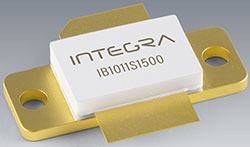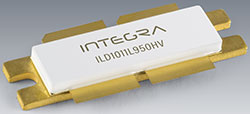The best solid-state, high-power amplifiers (HPA), especially those used in critical defense, aerospace and weather-radar applications, start with the right choice of discrete or integrated RF power transistors. Several active device semiconductor technologies are available today to amplify pulsed and continuous-wave (CW) signals across narrow or wide bandwidths from HF/VHF/UHF to L-, S-, C- and X-Band frequencies and beyond. Transistors for use in RF/microwave HPAs include some well-established, legacy device technologies such as silicon bipolar power transistors, as well as more recent power-transistor technologies such as Si LDMOS and GaN on SiC high-electron-mobility transistor (HEMT) power transistors.
Depending on frequency, bandwidth and other requirements, each transistor technology offers its own set of performance benefits in terms of output power, gain and efficiency. But evaluating the tradeoffs related to cost and value can be a daunting task. This article will cover the key things to look for and the advantages and disadvantages of each technology, while providing a few examples of ideal fits for certain types of applications at different frequencies and under different waveform conditions, focusing mostly on pulsed applications.
Application Considerations

Figure 1 Silicon bipolar power transistor that is capable of 1400 W output power at 1030 or 1090 MHz with 10 μs pulse widths at 1 percent duty cycle.
RF power transistors are usually characterized for the type of signals that they will handle, such as CW or pulsed signals. And when amplifying pulsed signals, the range of signal conditions are the most complex such as defined by pulse width and pulse duty cycle. Although different types of RF/microwave power transistors are capable of high-power efficiency, no power transistor is 100 percent power efficient, as some DC and RF power supplied to a transistor will inevitably be lost as heat (which also must be dissipated). Amplifying CW signals, or long-pulse length and/or high duty-cycle pulses, will result in more heat from one transistor technology than another and will vary when compared to handling short pulses or low duty-cycle pulses. As a result, there is no “silver bullet” technology for all of today’s high-power amplification requirements. The best solution is to match up the key characteristics of a transistor type to the most important application requirements. This becomes not only a spec-to-spec comparison exercise, it also requires recognition of other system-level tradeoffs to arrive at the best combination of performance, reliability, thermal management and total bill of materials (BOM) cost for the HPA.
Si Bipolar Transistors
The Si bipolar junction transistor (BJT) is the oldest technology for pulsed applications, but it is not an obsolete technology. Si BJTs are still in regular manufacture and will continue to be manufactured for the foreseeable future due to the on-going demand and replacements. Even today, some attributes of Si BJT devices are unequalled by other technologies. For example, Si BJT amplifiers have the smallest, lowest cost circuits and only need a single positive supply voltage. Nevertheless, newer HPA designs generally do not include Si BJT devices because of their low RF gain and their need for expensive and environmentally unfriendly BeO packages. An example of a Si BJT designed for IFF/SSR applications is shown in Figure 1. This device delivers typically > 1400 W output power at either 1030 or 1090 MHz with > 9.8 dB gain and 48 percent efficiency with 10 μs, 1 percent duty-cycle pulses.
Si LDMOS

Figure 2 Silicon LDMOS power transistor with 1100 W pulsed output power under Mode S ELM for IFF/SSR applications at 1030 MHz.
Si LDMOS is a mature technology like Si bipolar and has found widespread use in high linearity communication applications as well as in broadband CW amplifiers. It is also a great choice for pulsed applications up to L-Band. L- through S-Band LDMOS transistors are available but their performance is typically inferior to that available from GaN HEMT devices at this frequency. Si LDMOS is well-suited to long-pulse and/or high duty-cycle applications because of its very low thermal resistance per Watt that also contributes to its excellent VSWR withstanding characteristics. The limiting factor of Si LDMOS, however, is that it offers inferior power efficiency to both Si bipolar and GaN HEMT devices.
Figure 2 shows an example of a state-of-the-art Si LDMOS transistor for L-Band avionics applications. This transistor typically delivers 1100 W at 1030 MHz under the demanding Mode S ELM waveform (48 × {32 μs on, 18 μs off}, 6.4 percent long-term duty cycle) with 16 dB gain and 55 percent efficiency. A unique feature of this device is that it is a single-ended rather than a push-pull transistor. Consequently, it requires a smaller, less expensive and simpler circuitry since no balun is required. This type of added functionality is also something that should be considered when comparing datasheets.
